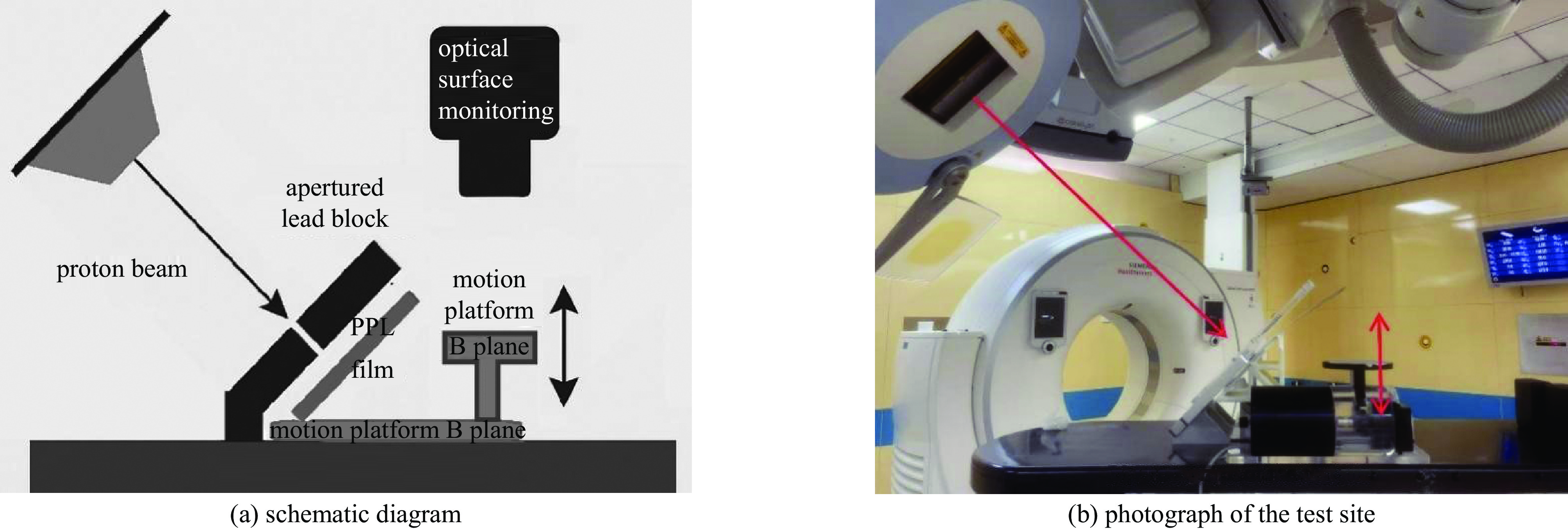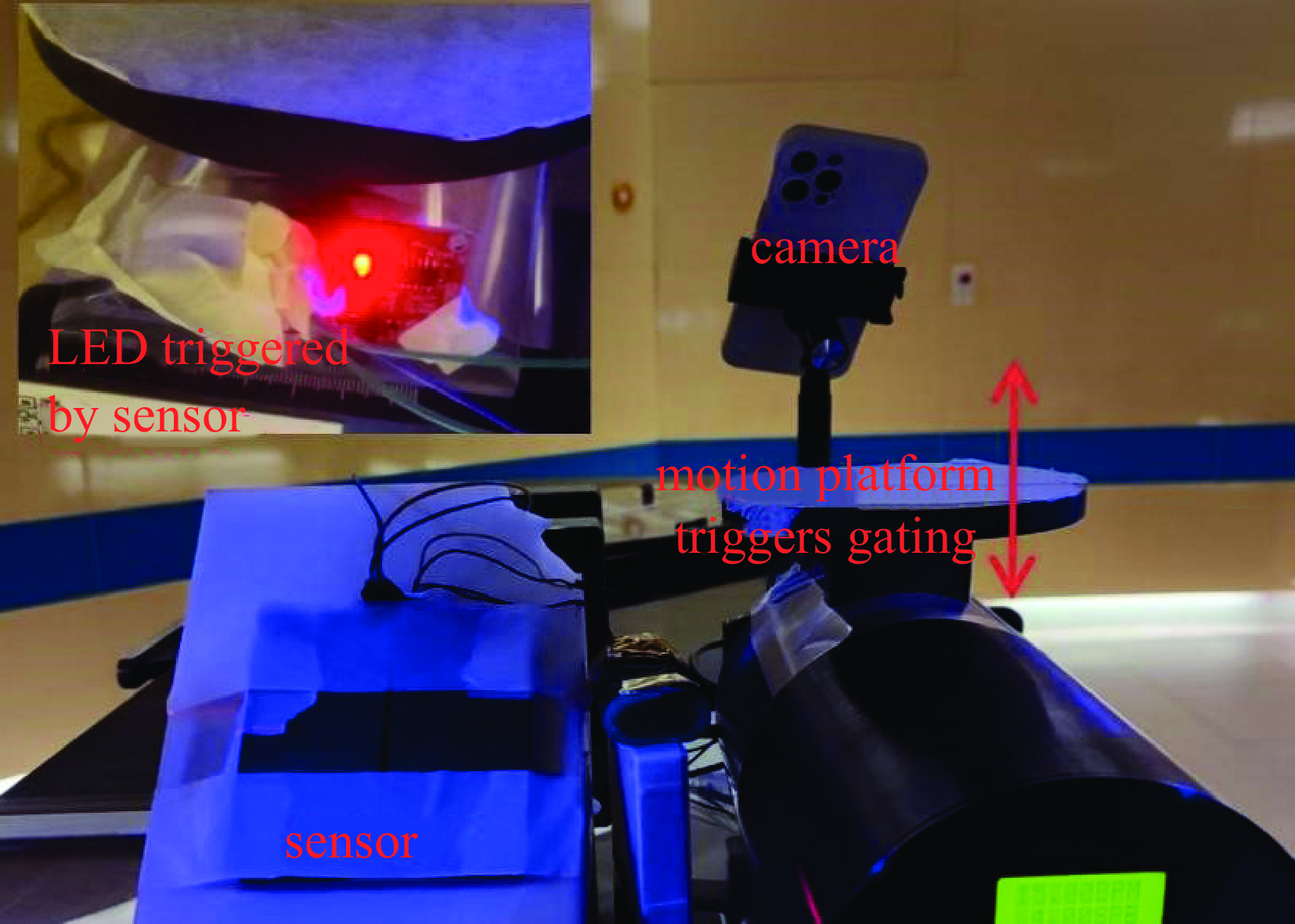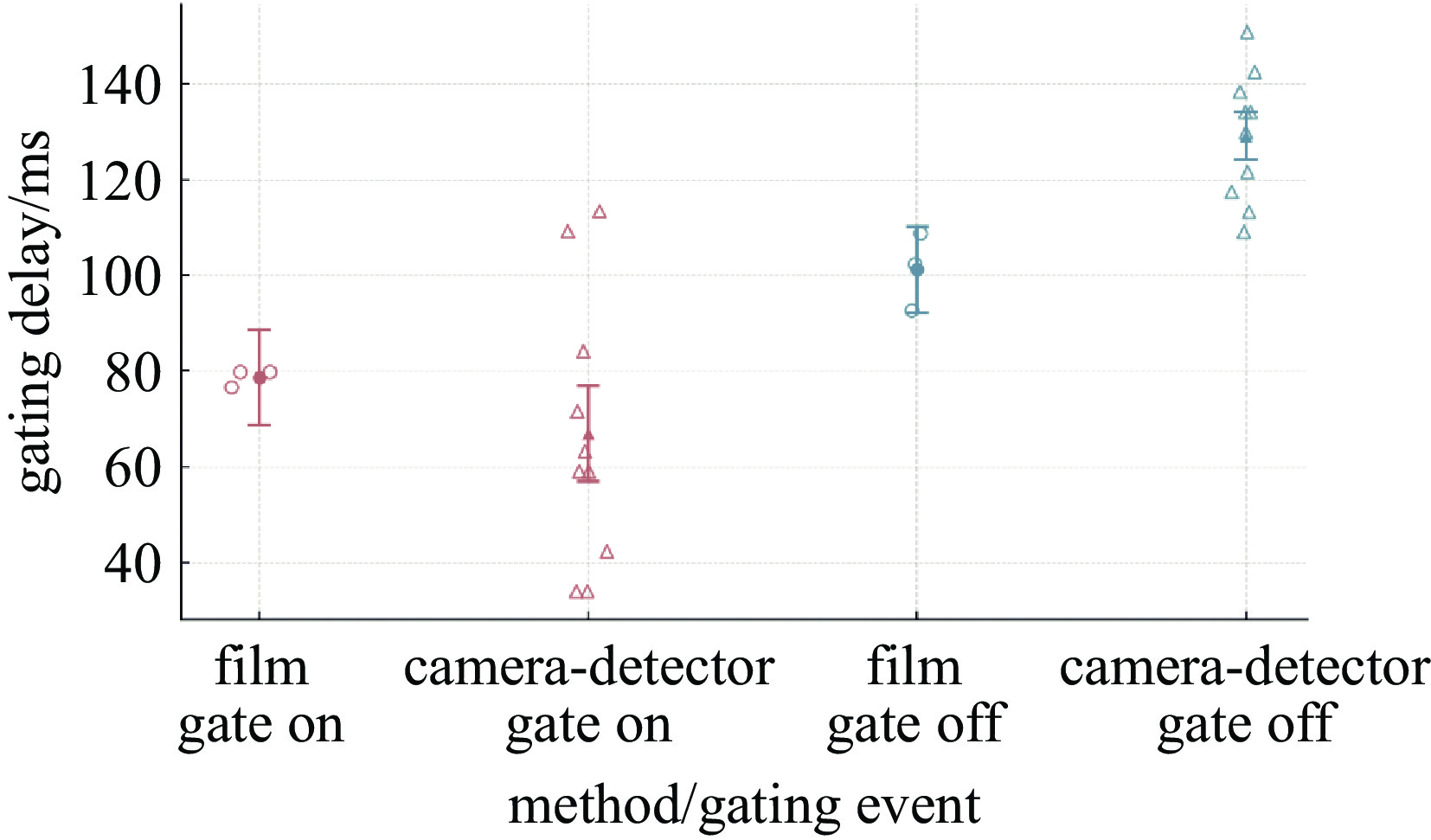Measurement and analysis of gating latency in surface-guided particle therapy
-
摘要: 粒子放疗对呼吸运动高度敏感,低延迟的呼吸门控是确保剂量准确的重要前提。光学体表引导(SGRT)因其具备连续监测与无电离辐射的特性,在粒子放疗中的应用日益增多,成为了呼吸门控的重要手段。然而,放疗领域对于SGRT-质子重离子门控系统时间延迟的验证仍然有限。采用两种不同方法测量SGRT-质子重离子放疗系统的开启与关闭延迟,对两种实验方法进行比较,评估SGRT-质子重离子门控系统的延迟性能,为该技术的应用提供依据。开展两种测量:其一为PPL胶片法,质子束穿越1.5 mm直径的开孔挡铅,在胶片上呈现包含延迟特性的条带状图案,使用扫描仪以0.10 mm分辨率分析胶片条带;其二为高速相机-探测器法,以240 帧/s的高速相机拍摄到达门控条件的时间与探测器接收辐射信号的时间差,计算开启与关闭延迟。本研究通过两种不同的实验方法对门控延迟进行端到端测量,并以合成不确定度进行交叉验证测量结果。采用胶片法与相机-探测器法测得的门控开启延迟分别为79 ms±10 ms和67 ms±10 ms;对应的门控关闭延迟分别为101 ms±9 ms和129 ms±5 ms。该SGRT-质子重离子呼吸门控系统满足我院临床需求。本研究论证了多方法交叉验证门控延迟的可行性和必要性,为SGRT在粒子放疗中的推广与验收提供了量化依据。Abstract:
Background Particle therapy is highly sensitive to respiratory motion, and low-latency respiratory gating is essential to ensure dose accuracy. Surface-guided radiation therapy (SGRT), featuring continuous monitoring and a non-ionizing workflow, is increasingly adopted in particle therapy and has become an important approach to respiratory gating. However, validation of gating latency for SGRT-guided proton and heavy ion systems remains limited in this area.Purpose To measure the gate-on and gate-off latencies of an SGRT-proton and heavy ion radiotherapy system using two different methods, compare the two experimental approaches, and evaluate the latency performance of the SGRT-guided system to inform its clinical application.Methods Two measurements were conducted using a PPL film method and a high-speed camera-detector method. In the film method, a proton beam traversed a 1.5-mm-diameter aperture in a lead collimator, producing on the film a striped pattern that encodes latency; the films were digitized at 0.10 mm resolution for analysis. In the camera-detector method, a 240 frames/s high-speed camera recorded the instant the gating condition was met, and gate-on and gate-off delays were computed from the time difference to the detector-registered radiation signal. End-to-end latency was measured with both methods, and results were cross-validated using combined uncertainty.Results The gate-on latency measured by the film method and the camera–detector method was 79 ms±10 ms and 67 ms±10 ms, respectively; the corresponding gate-off latency was 101 ms±9 ms and 129 ms±5 ms. Across two measurement methods, gate-on latencies were concordant within the combined standard uncertainty, whereas gate-off latency showed a significant method-dependent discrepancy, indicating systematic bias.Conclusions The SGRT-proton and heavy ion gating system meets our clinical requirements. This study demonstrates the feasibility and necessity of multi-method cross-validation of gating latency and provides quantitative evidence for the commissioning and acceptance test of SGRT in particle therapy. -
表 1 胶片法与相机法的B类典型最大误差估算
Table 1. Typical maximum type B uncertainty estimation for the film method and the camera-detector method
method uncertainty component label typical maximum error estimation film method OD 50% criterion a1 ±0.2 mm scanning resolution error a2 ±0.1 mm film development uncertainty a3 ±0.5 mm motion platform repeatability a4 ±0.2 mm camera-detector method nominal frame rate error a5 ±0.1 ms frame interval jitter a6 ±0.1 ms LED indicator delay a7 ±4 ms discrepancy between resonance
midpoint and LED-on criteriona8 ±4.18 ms (1 frame) 表 2 胶片法与相机-探测器法测量门控延迟的均值和不确定度统计
Table 2. Statistics of the mean and uncertainty for gating latency measured by the film method and the camera–detector method
item method standard
deviation/mstype A uncertainty
$ {u}_{\mathrm{A}} $/mstype B uncertainty
$ {u}_{\mathrm{B}} $/msmean ± combined
uncertainty/msbeam-on
gating latencycamera–detector method 28 9 3 67±10 film method 2 1 10 79±10 beam-off
gating latencycamera–detector method 13 4 3 129±5 film method 8 5 7 101±9 -
[1] Parodi K, Polf J C. In vivo range verification in particle therapy[J]. Medical Physics, 2018, 45(11): e1036-e1050. [2] Durante M, Orecchia R, Loeffler J S. Charged-particle therapy in cancer: clinical uses and future perspectives[J]. Nature Reviews Clinical Oncology, 2017, 14(8): 483-495. doi: 10.1038/nrclinonc.2017.30 [3] Kubiak T. Particle therapy of moving targets—the strategies for tumour motion monitoring and moving targets irradiation[J]. British Journal of Radiology, 2016, 89: 20150275. doi: 10.1259/bjr.20150275 [4] Lebbink F, Stock M, Georg D, et al. The influence of motion on the delivery accuracy when comparing actively scanned carbon ions versus protons at a synchrotron-based radiotherapy facility[J]. Cancers, 2022, 14: 1788. doi: 10.3390/cancers14071788 [5] Lu H M, Brett R, Sharp G, et al. A respiratory-gated treatment system for proton therapy[J]. Medical Physics, 2007, 34(8): 3273-3278. doi: 10.1118/1.2756602 [6] Otani Y, Fukuda I, Tsukamoto N, et al. A comparison of the respiratory signals acquired by different respiratory monitoring systems used in respiratory gated radiotherapy[J]. Medical Physics, 2010, 37(12): 6178-6186. doi: 10.1118/1.3512798 [7] Freislederer P, Kügele M, Öllers M, et al. Recent advances in surface guided radiation therapy[J]. Radiation Oncology, 2020, 15: 187. doi: 10.1186/s13014-020-01629-w [8] Naumann P, Batista V, Farnia B, et al. Feasibility of optical surface-guidance for position verification and monitoring of stereotactic body radiotherapy in deep-inspiration breath-hold[J]. Frontiers in Oncology, 2020, 10: 573279. doi: 10.3389/fonc.2020.573279 [9] Hanley J, Dresser S, Simon W, et al. AAPM Task Group 198 Report: an implementation guide for TG 142 quality assurance of medical accelerators[J]. Medical Physics, 2021, 48(10): e830-e885. [10] Al-Hallaq H A, Cerviño L, Gutierrez A N, et al. AAPM task group report 302: surface-guided radiotherapy[J]. Medical Physics, 2022, 49(4): e82-e112. [11] 吴泇俣, 嵇卫星, 张建英. 呼吸门控放射治疗中时间延迟的测量方法[J]. 中国医疗设备, 2022, 37(5): 161-165 doi: 10.3969/j.issn.1674-1633.2022.05.034Wu Jiayu, Ji Weixing, Zhang Jianying. Review of methods for measuring time delay in respiratory gated radiotherapy[J]. China Medical Devices, 2022, 37(5): 161-165 doi: 10.3969/j.issn.1674-1633.2022.05.034 [12] Chen Li, Bai Sen, Li Guangjun, et al. Accuracy of real-time respiratory motion tracking and time delay of gating radiotherapy based on optical surface imaging technique[J]. Radiation Oncology, 2020, 15: 170. doi: 10.1186/s13014-020-01611-6 [13] Barfield G, Burton E W, Stoddart J, et al. Quality assurance of gating response times for surface guided motion management treatment delivery using an electronic portal imaging detector[J]. Physics in Medicine & Biology, 2019, 64: 125023. [14] Yuze Y, Moyers M F, Zhang X. Reduced time-delay for beam gating using optical marker tracking and FPGA gating interface[C]//AAPM 66th Annual Meeting & Exhibition. 2024. [15] Worm E S, Thomsen J B, Johansen J G, et al. A simple method to measure the gating latencies in photon and proton based radiotherapy using a scintillating crystal[J]. Medical Physics, 2023, 50(6): 3289-3298. doi: 10.1002/mp.16418 [16] Tan H Q, Koh C W Y, Lew K S, et al . Real-time gated proton therapy with a reduced source to imager distance: Commissioning and quality assurance[J]. Physica Medica, 2024, 122: 103380. doi: 10.1016/j.ejmp.2024.103380 -





 下载:
下载:




